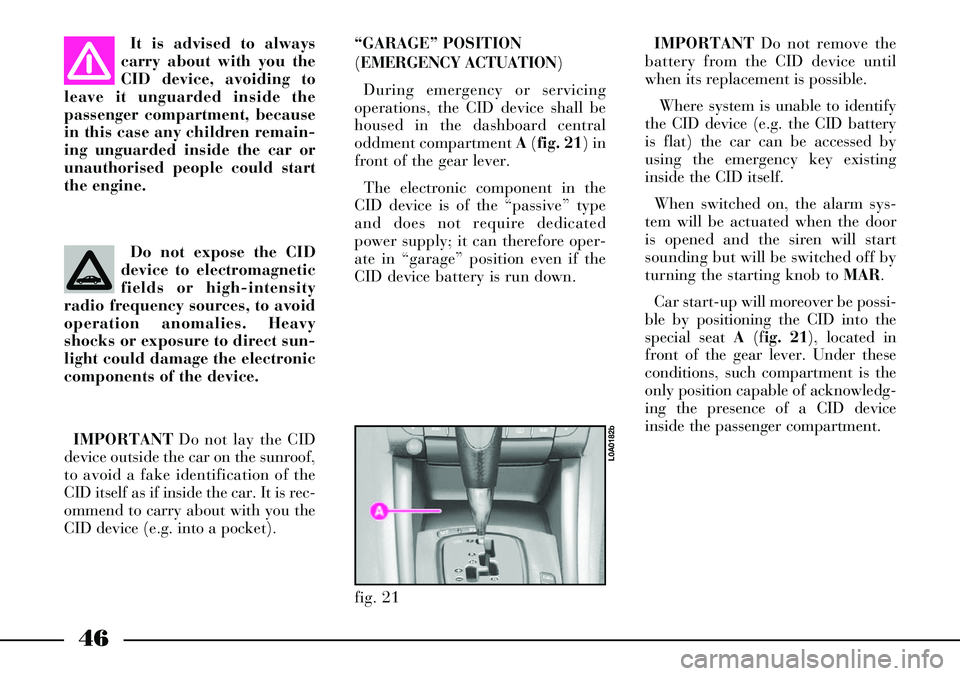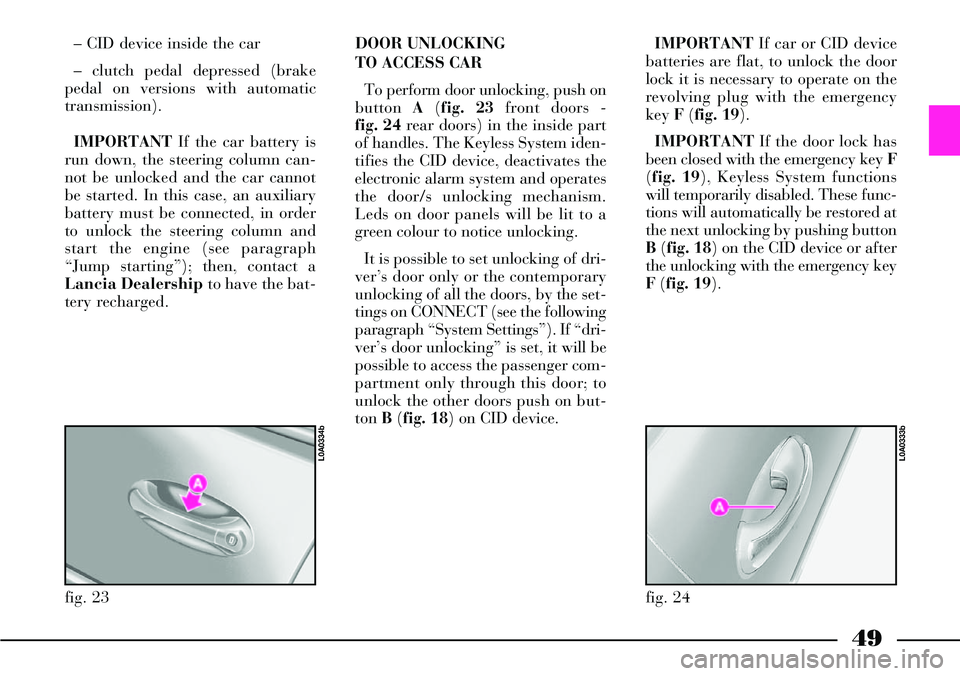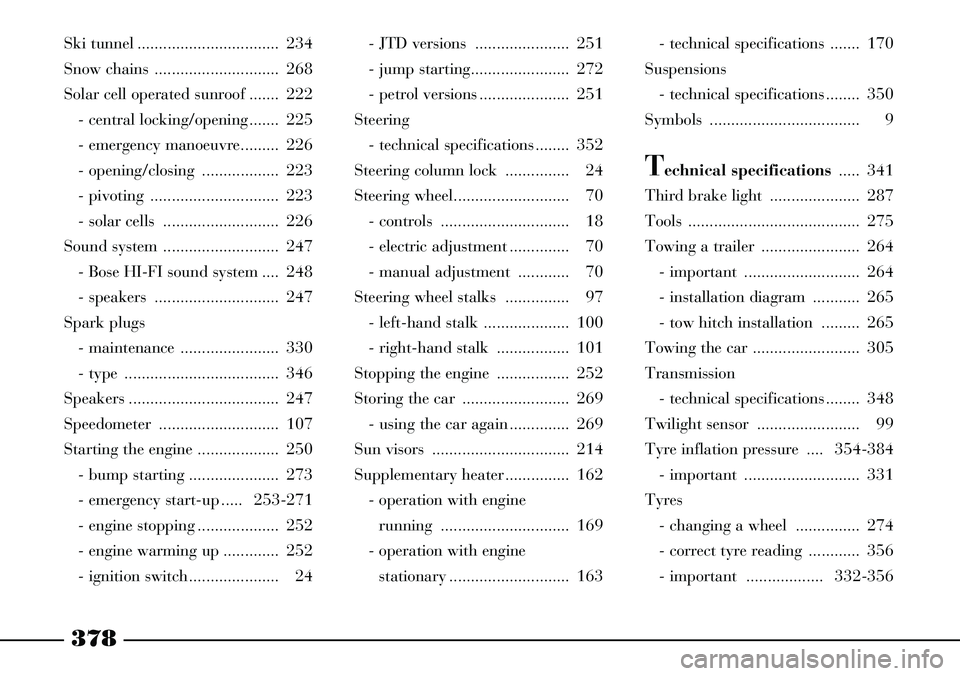run flat Lancia Thesis 2007 Owner handbook (in English)
[x] Cancel search | Manufacturer: LANCIA, Model Year: 2007, Model line: Thesis, Model: Lancia Thesis 2007Pages: 386, PDF Size: 8.69 MB
Page 47 of 386

46
IMPORTANTDo not remove the
battery from the CID device until
when its replacement is possible.
Where system is unable to identify
the CID device (e.g. the CID battery
is flat) the car can be accessed by
using the emergency key existing
inside the CID itself.
When switched on, the alarm sys-
tem will be actuated when the door
is opened and the siren will start
sounding but will be switched off by
turning the starting knob to MAR.
Car start-up will moreover be possi-
ble by positioning the CID into the
special seat A(fig. 21), located in
front of the gear lever. Under these
conditions, such compartment is the
only position capable of acknowledg-
ing the presence of a CID device
inside the passenger compartment.
fig. 21
L0A0182b
It is advised to always
carry about with you the
CID device, avoiding to
leave it unguarded inside the
passenger compartment, because
in this case any children remain-
ing unguarded inside the car or
unauthorised people could start
the engine.
Do not expose the CID
device to electromagnetic
fields or high-intensity
radio frequency sources, to avoid
operation anomalies. Heavy
shocks or exposure to direct sun-
light could damage the electronic
components of the device.
IMPORTANTDo not lay the CID
device outside the car on the sunroof,
to avoid a fake identification of the
CID itself as if inside the car. It is rec-
ommend to carry about with you the
CID device (e.g. into a pocket). “GARAGE” POSITION
(EMERGENCY ACTUATION)
During emergency or servicing
operations, the CID device shall be
housed in the dashboard central
oddment compartment A(fig. 21) in
front of the gear lever.
The electronic component in the
CID device is of the “passive” type
and does not require dedicated
power supply; it can therefore oper-
ate in “garage” position even if the
CID device battery is run down.
Page 50 of 386

49
– CID device inside the car
– clutch pedal depressed (brake
pedal on versions with automatic
transmission).
IMPORTANTIf the car battery is
run down, the steering column can-
not be unlocked and the car cannot
be started. In this case, an auxiliary
battery must be connected, in order
to unlock the steering column and
start the engine (see paragraph
“Jump starting”); then, contact a
Lancia Dealershipto have the bat-
tery recharged.DOOR UNLOCKING
TO ACCESS CAR
To perform door unlocking, push on
button A(fig. 23front doors -
fig. 24rear doors) in the inside part
of handles. The Keyless System iden-
tifies the CID device, deactivates the
electronic alarm system and operates
the door/s unlocking mechanism.
Leds on door panels will be lit to a
green colour to notice unlocking.
It is possible to set unlocking of dri-
ver’s door only or the contemporary
unlocking of all the doors, by the set-
tings on CONNECT (see the following
paragraph “System Settings”). If “dri-
ver’s door unlocking” is set, it will be
possible to access the passenger com-
partment only through this door; to
unlock the other doors push on but-
ton B(fig. 18) on CID device.
fig. 23
L0A0334b
IMPORTANTIf car or CID device
batteries are flat, to unlock the door
lock it is necessary to operate on the
revolving plug with the emergency
key F (fig. 19).
IMPORTANTIf the door lock has
been closed with the emergency key F
(fig. 19), Keyless System functions
will temporarily disabled. These func-
tions will automatically be restored at
the next unlocking by pushing button
B(fig. 18) on the CID device or after
the unlocking with the emergency key
F(fig. 19).
fig. 24
L0A0333b
Page 180 of 386

179
The car is fitted also with an emer-
gency button A(fig. 134), placed in
the boot right compartment, which
can be used to unblock the car if it has
been stopped on the road for a break-
down or an accident and the key can-
not be turned to MAR(accident with
fire risk). To reach the button remove
the compartment cover turning the
catch A(fig. 135) to 1with the igni-
tion key.
To disengage the parking brake
through the emergency button pro-
ceed as follows:
– press and release the main button
on the central console
– press and release the emergency
button in the boot
– press again and release the main
button on the central console.
The time elapsed between these
operations should be lower than 30
seconds.MANUAL GEARBOX
To engage the gears, press down
the clutch and put the gear lever into
one of the positions shown in the
diagram (fig. 136); the diagram is
also on the gear lever knob.
To engage reverse (R), wait for the
car to come to a standstill and lift
the ring Aunder the knob (with the
fingers of the hand operating the
lever).
Release the ring after engaging
reverse gear. You do not need to lift
the ring to disengage reverse.To change gear properly
you must push the clutch
pedal fully down. It is
therefore essential that there is
nothing under the pedals: make
sure mats are lying flat and do
not get in the way of the pedals.
Reverse can only be
engaged when the car is at
a standstill. Wait for two
seconds or longer with the clutch
fully pressed before engaging
reverse when the engine is run-
ning to prevent scraping and
damaging the gears.
Do not drive with your
hand resting on the gear
stick as the force exerted,
even if only slight, could lead to
premature wearing of the gear-
box internal components.
fig. 136
L0A0357b
Page 182 of 386

181
Do not tax the engine
until it has not reached
operating temperature.
STOPPING THE CAR
To stop the car press the brake
pedal, regardless of the gear lever
position.
If the brake pedal is not
pressed, when the gear
lever is to D or R and the
engine is running idle, even on a
flat ground, the car starts moving.The ignition key can be extracted
from the ignition switch only when
the gear lever is at P(Key-lock safe-
ty) and the ignition key is at STOP.
Letter Pon the instrument panel
display (fig. 138) will come on for
30 seconds, then it will go off.IMPORTANTIn case of emer-
gency (failures, flat battery, etc.), it
is possible to remove the ignition key
even if the gear lever is not at P. To
do this, turn the key to STOP, press
button A(fig. 139) and at the same
time remove the key.
fig. 138
L0A0238b
fig. 139
L0A0178b
Page 184 of 386

183
R - Reverse
Shift the lever to Rwith the car
stationary, the engine running idle
and the brake pedal pressed.
When the lever is at Rbackup
lights turn on and a buzzer will
sound for about 4 seconds to warn
other people that reversing is in
progress.
IMPORTANTEven with the lever
in position R, the reverse gear can-
not be engaged if the car speed is
higher than the established value.
When the speed is reduced, the
reverse gear can be engaged and it
remains engaged even if the car
speed overcomes that limit.N - Neutral
This is the position to be used when
the car must be pushed or towed.
D - Forward gear (automatic)
This is the position to be used when
all automatic gearbox functions are
required.
The electronic control unit controls
that the five gears are engaged auto-
matically according to car speed,
engine rpm, accelerator pedal posi-
tion and pressing speed, together
with the main driving conditions
such as hills, slopes, curves and
braking.
Indeed, the electronic automatic
gearbox is able to choose, according
to the type of driving adopted by the
driver, different programmes subdi-
vided into comfortable driving,
economy driving and sporty driving,
with shift points ranging between
low and high. Before leaving the car,
check that the electric
parking brake (EPB) is
on. Shift the lever to position P
even when the car is left with the
engine running.
In case of emergency (failures, flat
battery, etc.), it is possible to shift
the lever from position Pto N, D or
Rby pressing lever A(fig. 141) set
under the gear lever mask. To reach
the lever, remove the press-fit odd-
ment compartment shelf Bin front
of the gearshift lever.
fig. 141
L0A0276b
Page 186 of 386

185
Winter programme
When starting to drive with a
reduced road grip (snow-covered,
icy road, etc.), the shift control unit
automatically engage the “ICE” pro-
gramme.
This programme allows starting
with the 2
ndgear engaged, in order to
improve the gear shift efficiency
according to grip conditions.
“ICE” programme activation is
possible only when the gear lever is
at D. If the lever is in the sequential
gear sector, the gear engaged at the
moment of moving off is always that
selected by the driver.
When the “ICE” programme has
been activated, Kickdown is not
operating.Kick down
When maximum acceleration is
required (e.g. during overtaking), if
the accelerator is rapidly and fully
depressed, lower gears are automat-
ically engaged, provided the engine
rpm enable this operation.
Later, when the accelerator pedal
is released, the gear engaged is
selected according to the type of dri-
ving and the position of the acceler-
ator.
Kick-down can be engaged only
when the gear lever is at D.
IMPORTANTIt is suggested to use
Kick-down only when required, e.g.
during overtaking, to limit the fuel
consumption.
When the engine is run-
ning idle and the lever is
at D, the car starts moving
even if on a flat ground: keep the
brake pedal pressed until moving
off. formance is requested in terms of
acceleration and maximum speed,
this gear is almost never selected.
The electronic automatic gearbox
is fitted with a device reducing
inside gearing dragging when the car
is stationary and the brake pedal
depressed. The advantages of such a
function are a considerable noise
reduction, with consequent vibra-
tion reduction and limited fuel con-
sumption.
Page 189 of 386

188
If the failure is signalled when the
engine is started, it means that the
electronic control unit had stored it
previously, before stopping the
engine. Even in this case, go to a
Lancia Dealershipto have the
automatic gearbox checked.
When driving with auto-
matic gearbox faulty,
drive carefully consider-
ing the limited car efficiency in
terms of acceleration and speed.
In addition, when driving with
automatic gearbox faulty, the
reverse block might not be oper-
ating: for this reason it is
absolutely necessary to move the
lever to position R while the car
is moving.SOUND SIGNAL
A buzzer will sound in the follow-
ing conditions:
– for about 15 seconds when the
driver’s door is opened while the
engine is running or not and the gear
lever has a position different from P
– for about 15 seconds when the
engine is turned off and the gear
lever has a position different from P
– for about 4 seconds when the
gear lever is shifted to R(reverse)
– with the manual sequential oper-
ation on, when the selected gear is
not accepted by the electronic con-
trol unit (e.g. since it might generate
a runaway speed rate). BUMP STARTING
Never bump starting the engine (by
pushing, towing, etc.). In an emer-
gency, when the battery is flat, start
the engine with the appropriate
emergency battery according to the
instructions contained in chapter “In
an emergency”.
Page 268 of 386

267
WINTER TYRES
These tyres have been specifically
designed for use on snow and ice
and should be fitted in place of the
existing tyres.
Use only the homologated tyres
listed in log book.
Lancia Dealershipswill be glad
to provide advice on the most suit-
able type of tyres according to your
needs.
For information on the tyres to be
fitted, inflation pressure and winter
tyre specifications, follow the pre-
scriptions given in “Technical speci-
fications”.
The performance of winter tyres is
greatly reduced when the tread
depth is less than 4mm. In this situ-
ation it would be safer to have them
replaced.Due to winter tyre features, under
normal conditions of use or on long
motorway journeys, the perfor-
mance of these tyres is lower than
that of standard tyres.
The use of these tyres should there-
fore be limited to the conditions for
which they were designed and certi-
fied.
IMPORTANT When using winter
tyres with a maximum speed index
below the one that can be reached
by the car (increased by 5%), place
a suitable notice in the passenger
compartment to inform the driver of
the top speed at which the winter
tyre can run (as per EC Directive).All four tyres should be the same
(brand and track), to ensure greater
safety when driving, braking and
cornering.
Remember that it is inappropriate
to change the direction of rotation of
tyres.
The maximum speed for winter
tyres with “Q” marking is 160
km/h, with “T” marking is 190
km/h, whereas with “H” marking is
210 km/h. Always respect the high-
way code speed limit.
Page 305 of 386

304
IF THE BATTERY
IS FLAT
First of all, read the “Car mainte-
nance” chapter for the steps to be
taken to avoid the battery running
down and to ensure it has a long life.
RECHARGING THE BATTERY
IMPORTANTThe description of
the battery recharging procedure is
just for information. To carry out
this procedure go to a Lancia
Dealership.
You are advised to recharge the
battery slowly for a period of
approximately 24 hours at a low
amperage. Charging for too long
could damage the battery.Before reloading, care-
fully read and comply with
the instructions contained
in the previous paragraph “If bat-
tery is to be disconnected”.
Proceed as follows:
– Disconnect the terminal from the
battery negative pole (-).
– Connect the charger cables to the
battery terminals (observe polarity).
– Turn on the charger.
– When you have finished, turn the
charger off before disconnecting the
battery.
– Reconnect the terminal to the
battery negative pole (-).The liquid in the battery
is poisonous and corro-
sive. Do not let it touch
the skin or eyes. Recharging the
battery should be done in a well-
ventilated area and away from
naked flames or possible sources
of sparks: explosion and fire risk.
JUMP STARTING
See “Jump starting” in this chap-
ter.
Page 379 of 386

378
Ski tunnel ................................. 234
Snow chains ............................. 268
Solar cell operated sunroof ....... 222
- central locking/opening ....... 225
- emergency manoeuvre......... 226
- opening/closing .................. 223
- pivoting .............................. 223
- solar cells ........................... 226
Sound system ........................... 247
- Bose HI-FI sound system .... 248
- speakers ............................. 247
Spark plugs
- maintenance ....................... 330
- type .................................... 346
Speakers ................................... 247
Speedometer ............................ 107
Starting the engine ................... 250
- bump starting ..................... 273
- emergency start-up ..... 253-271
- engine stopping ................... 252
- engine warming up ............. 252
- ignition switch ..................... 24- JTD versions ...................... 251
- jump starting....................... 272
- petrol versions ..................... 251
Steering
- technical specifications ........ 352
Steering column lock ............... 24
Steering wheel........................... 70
- controls .............................. 18
- electric adjustment .............. 70
- manual adjustment ............ 70
Steering wheel stalks ............... 97
- left-hand stalk .................... 100
- right-hand stalk ................. 101
Stopping the engine ................. 252
Storing the car ......................... 269
- using the car again .............. 269
Sun visors ................................ 214
Supplementary heater ............... 162
- operation with engine
running .............................. 169
- operation with engine
stationary ............................ 163- technical specifications ....... 170
Suspensions
- technical specifications ........ 350
Symbols ................................... 9
Technical specifications..... 341
Third brake light ..................... 287
Tools ........................................ 275
Towing a trailer ....................... 264
- important ........................... 264
- installation diagram ........... 265
- tow hitch installation ......... 265
Towing the car ......................... 305
Transmission
- technical specifications ........ 348
Twilight sensor ........................ 99
Tyre inflation pressure .... 354-384
- important ........................... 331
Tyres
- changing a wheel ............... 274
- correct tyre reading ............ 356
- important .................. 332-356